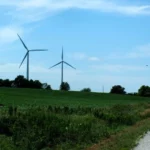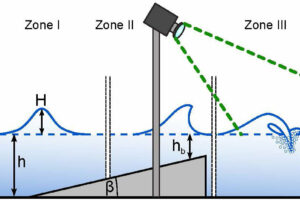Renewable electricity has pushed through a series of positive tipping points in recent years, with 2023 set to pass a major milestone.
This year, the world is predicted to pass a critical turning point in renewable energy.
Greenhouse gas emissions from the power sector, the largest source of the world’s emissions, are expected to fall for the first time, according to London-based think tank Ember. That’s despite the fact that the world’s demand for electricity is still growing. Emissions are set to fall because expansion in renewable energies such as solar and wind is outstripping that growth in demand.
It’s a crucial moment in the effort to tackle climate change, and the report, written by Małgorzata Wiatros-Motyka, senior electricity analyst at Ember, and colleagues, argues that we are fast approaching a positive “tipping point” in the effort to curb climate change.
“This marks the point where power sector emissions stop rising,” Wiatros-Motyka and her colleagues write. “Clean power can actually go to replacing fossil fuels, instead of just meeting rising demand.”
Just how important are positive tipping points in efforts to tackle climate change? And are we really about to pass an important one in 2023?
Future Planet editor Martha Henriques puts these questions to Simon Sharpe, author of Five Times Faster: Rethinking the Science, Economics, and Diplomacy of Climate Change.
MH: We’re used to hearing about dangerous tipping points in climate change, like the loss of sea ice or forests. What is a tipping point, and why are some of them good?
SS: A tipping point in general is a point where a small input change leads to a large change in outcome. An example I give is, if you lean back too far in your chair, there’s a certain point where just a tiny bit further and you’ll fall over backwards.
In climate change, as you say, there are bad tipping points, like when a forest might be lost irreversibly, or ice shelves are tipped into irreversible melting and disintegration.
When we talk about good tipping points, then we’re referring to technology transitions and the move from old technologies based on fossil fuels, to new ones, the zero-emission technologies.
MH: So what happens when we pass a positive climate tipping point?
SS: This is really the guts of the climate change problem: it’s about technology transitions, in each of the emitting sectors: in power generation, transport, buildings, industry and agriculture.
The crucial thing is, before a tipping point, the force in the system is trying to hold back the transition. You’ve got people finding that the older technology is still more convenient or more attractive or cheaper. And it takes real effort to try and help the new technology grow and establish itself.
But beyond the tipping point, actually, it’s reversed and the momentum is with the new technology. It’s growing fast, and it’s benefiting from these really strong, reinforcing feedbacks – the more people buy it, the more people invest in it, its cost comes down, it improves, and then more people want to buy it, and this keeps going around and around. Once you’re past that tipping point, the transition tends to accelerate.
MH: And these positive tipping points can happen for many different technologies, not just climate-related ones?
SS: I think it’s reasonable to say that in any technology transition, at some point there is a tipping point – that is the place where the new technology becomes better than the old. Consumers prefer to have it, producers prefer to make it, and investors pile into the new and abandon the old. That’s when the transition really takes off.
To give a non-climate example – think back to the transition from horses to cars. I like to think about how it was at the beginning of that transition: cars didn’t look good. Cars were slower, they were expensive, they were less reliable, they were more dangerous. Nobody wanted a car at the beginning of that transition, except for some crazy people that wanted one for a toy, or inventors. But there came a point when suddenly cars were better than horses. Then the transition became fast and irreversible.
MH: And now we’re seeing a similar picture for clean electricity?
SS: Yes, we very much see the same thing happening in the power sector. And, in fact, there’s not just one but a series of tipping points.
I would say that the first one was when new solar and wind power became cheaper than new coal and gas power – and that’s already in the rear-view mirror. That’s the case in the vast majority of countries in the world.
A second one that we’re already beginning to pass now is new solar and wind generation becoming cheaper than existing fossil fuel generation. So, in other words, it’s cheaper to build a solar or a wind plant than it is to keep shovelling coal into a coal power station or piping gas into a gas power station.
A third tipping point, which we’re coming up towards, is when renewables plus energy storage become cheaper than coal and gas power. There’s a piece of analysis from researchers at Exeter University which predicts that by the end of this decade, solar power plus storage will be half the cost of coal in big markets, in the EU, China, India, Japan, the US. So actually, we’ll cross that tipping point really soon in the next few years.
MH: So we’ve got this cluster of positive tipping points that we’ve already passed or are on the horizon – what are the challenges ahead?
SS: There are still huge difficulties to overcome. That includes upgrading the grids, dealing with the socioeconomics of the transition, dealing with the vested interests, restructuring electricity markets. There’s a lot that has to be done.
But as we pass each of these different points, then everybody’s confidence in the transition grows, and its inevitability grows as well.
MH: This week’s report predicting a peak in emissions from the global power sector – is it a true tipping point?
SS: We’ve talked about technology and economic tipping points – those are the ones to do with cost parity of competing technologies. But the cost-parity tipping point is just one kind of tipping point, it’s not the only kind. You can also have tipping points in confidence.
I think this report could, in fact, activate a tipping point in perceptions about our ability to deal with climate change. We’ve been talking about this negotiating it amongst countries since 1992 and we’ve known about it for a lot longer. And all of that time global emissions have been going up. They’ve been going up in every single one of the big-emitting sectors, and we’ve never yet seen them go down, except for exceptional occasions like the Covid-19 pandemic that don’t really count.
And if this projection is right, then 2023 is the year when the power sector emissions start going down instead of up – and everybody will see that’s not a fluke. It’s very foreseeable. It’s obvious that at some point the growth of the renewables overtakes the growth of our system as a whole, and emissions start coming down.
So when that actually happens, it’s the first major global emitting sector to go into emissions reduction instead of growth. I think there’s a good chance that this could be a tipping point in our political and social confidence that we can actually get a grip on this problem.
Source : BBC News











Add Comment